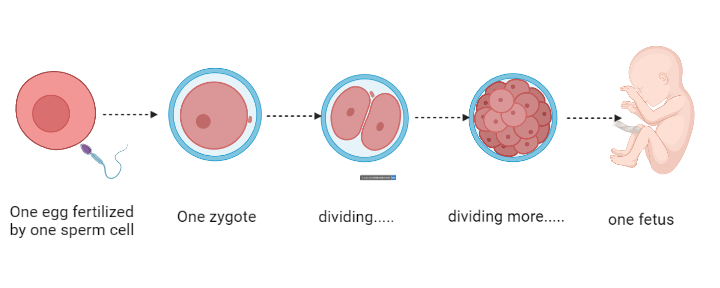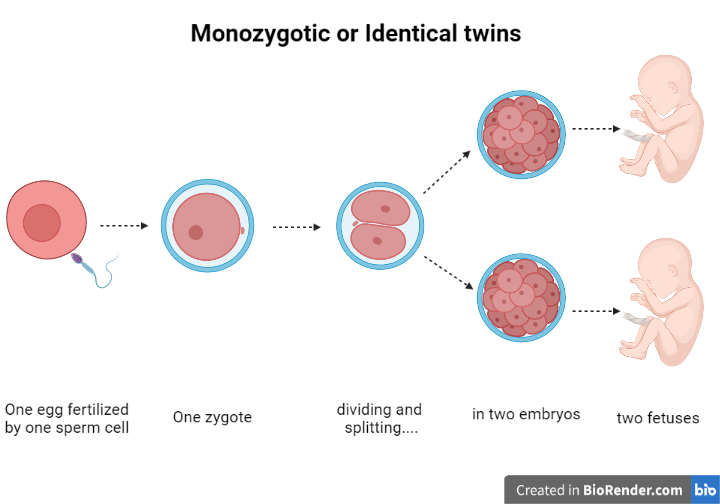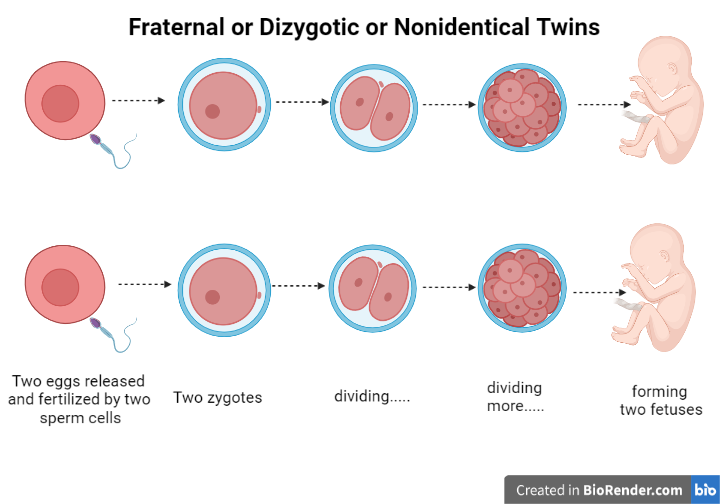Do you have any family members or friends that are twins? If so, can you tell them apart, or do they look like two peas in a pod? Either way, it is fascinating to think that a woman can deliver more than one baby at a time. These cases are called multiple births. Twins are the most common in comparison to triplets, quadruplets, and so on. However, have you wondered how twins are formed, what are the different types and what factors can affect the chance of having twins? Keep reading to find out more.

Most of the time, around the middle of a woman’s menstrual cycle, one egg is released from one of the two ovaries into the respective fallopian tube. For conception to occur, a sperm cell needs to make its way to the tube and find the egg. If at this stage, it manages to enter the egg, a zygote is produced. The zygote is the first cell of a new organism and can give rise to every cell of the baby that will slowly form inside the womb.

Then, how is it possible for two embryos to be developed? There are many types of twins. However, the two main categories are monozygotic and dizygotic twins. Monozygotic twins are always of the same sex, and they are also called identical because they look the same. Dizygotic twins or fraternal twins can be either the same or the opposite sex, and they look like a pair of siblings without being identical.
Monozygotic twins are derived from one egg fertilized by one sperm cell, meaning one zygote. The zygote then splits sooner or later, resulting in two sets of cells that will each form a whole baby. Since both babies occur from the same egg and sperm cell, they share the same genetic information, making them identical. Depending on the point in time at which the splitting occurs, the two embryos may have the same or different placentas or amniotic sacs. If the split occurs later than usual, the two embryos do not fully separate from each other, remaining attached to some parts of their bodies. These are called conjoined or Siamese twins. Even though monozygotic twins carry the same genetic information, they often present differences in their appearance or behavior, making each individual twin a unique person. That is the consequence of environmental factors that affect gene expression without altering the information printed in their genetic material.

Dizygotic twins are a different case. For dizygotic twins to be conceived, two eggs have to be released from the woman’s ovaries at the same menstrual cycle. In this case, both eggs may manage to be fertilized by two different sperm cells, resulting in two different individual zygotes that will each follow the programmed steps to give rise to an embryo as if it was the only one in the womb. In this case, the genes inside the two developing fetuses are not identical, which means that when the babies are born, they will look like any other brothers and sisters, only this time they will share their date of birth. They can either be both girls or both boys or a boy and a girl. That depends on the sex chromosome carried by the two sperm cells fertilizing the eggs, and one does not affect the other.

Scientists are curious to learn what are the factors affecting the possibility of a couple conceiving twins. Monozygotic twins seem to be a rare case. Therefore, it is not yet clear what factors drive the early embryo to split in two. According to a hypothesis based on families with a common occurrence of monozygotic twins, genes that are implicated in cell adhesion may play a role, as they affect the ability of the cells to remain connected to one another. Dizygotic twins, on the other hand, offer us a better understanding. When a woman tends to release more than one egg during the ovulation period, there is a higher chance for a twin pregnancy to occur. That situation is controlled by hormones and can either occur naturally or by practices followed in assisted reproduction. In the latter case, the woman’s body is prepared to get pregnant by increasing certain reproductive hormones. Also, when the eggs are harvested and fertilized in the lab, the doctor usually chooses more than one embryo for transfer in the womb to increase the chances of one or more of them being implanted. As a result, the possibility of carrying dizygotic twins increases too. That explains why there has been a rise in the birth of dizygotic twins in the last decades. Other factors affecting the development of dizygotic twins include heredity, the woman’s older age, and the number of previous pregnancies.
Sources:
https://medlineplus.gov/genetics/understanding/traits/twins/ https://www.genome.gov/genetics-glossary/identical-twins https://microbenotes.com/twins-types-causes-and-significance/ https://www.cell.com/ajhg/fulltext/S0002-9297(16)30043-X
